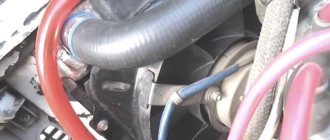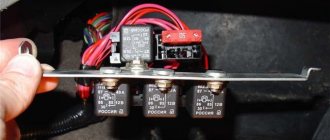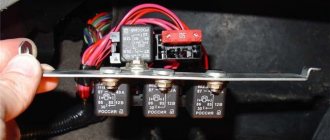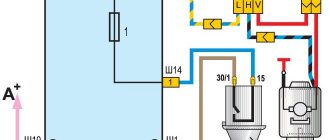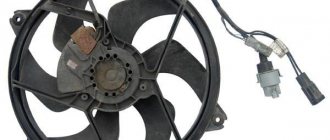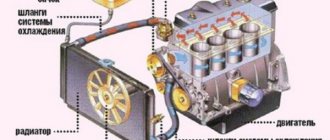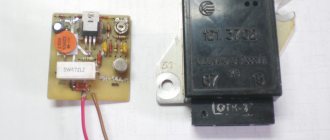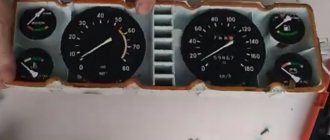The VAZ 2107, as a representative of the VAZ “classic”, has a fairly loud cooling fan. The moment of its connection cannot be missed. The vibration of the body increases, a hum is heard from under the hood, if the turn-on time coincides with an increased load on the electrical network (blinking turn signals when the low beam is on, heated rear window) - then the arrow of the load on the power network begins to slide into the red zone.
And even (if the carburetor is poorly adjusted), the emergency oil pressure light may start to burn. The cooling scheme of the VAZ 2107 is such that under normal conditions the fan does not turn on immediately, but only when a certain temperature in the system is reached. To determine this “convenient temperature moment” there is a sensor, or a fan on/off controller.
The location of the controller on the radiator is not accidental: after all, first the “small circle” of antifreeze is heated, then the cooling circuit provides for the passage of liquid through the radiator, the work of which is intensive heat exchange. And only when the temperature rises above 92 C°, the fan switch sensor is triggered.
About forced fan activation
The cooling circuit does not provide for constant fan operation. But in some cases it is possible to implement the principle of “forced fan connection”.
This is done if the sensor has failed and replacement on the road is impossible. You can check this as follows: the engine temperature controller has already shown the vertical position of the needle on the dial, it persistently “climbs” into the red zone, and the fan is silent and does not turn on. If this is the case, then there are most likely two possible reasons:
- The sensor itself, which turns on the fan of the VAZ 2107, has failed. This situation is more favorable than that described below. Firstly, the cooling circuit is complete, and the radiator works properly. This means that most of the heat is removed. There are two ways out of this situation; the following scheme of action is proposed:
- If there is a straight road ahead and the car will move without stopping, then you can monitor the temperature scale. In case of traffic jams or traffic lights, you can turn on the stove at full power at double blowing speed.
- You can decide to install forced fan activation. To do this, two contacts are pulled out of the controller and short-circuited. Attention! Before this, you must first remove the “minus, ground” from the battery. After the wires are short-circuited, the negative terminal is connected again, and the Carlson begins to work constantly, regardless of the engine temperature and the vehicle’s driving mode. After stopping the VAZ 2107, the fan will work until the battery is discharged, so after stopping you need to open the hood and disconnect the negative terminal.
This is very annoying for owners of a VAZ 2107 with central locking and an alarm system, so you can disconnect the fan wires, however, then they need to be reconnected and insulated. You also need to find a place for them in the engine compartment so that they do not get under the working impeller blades, because the layout of all the wires in the engine compartment is supposed to be in harnesses. Of course, it’s inconvenient to drive like this for a long time, because constantly opening and closing the hood to connect and turn off will get boring. In addition, no one will like constant noise, vibration and increased wear on the fan axis bearings. Forced activation is an emergency method.
Cooling fan VAZ 2107
In the power plants of the first "sevens" the radiator fan was installed directly on the water pump shaft. Like the pump, it was driven by a belt drive from the crankshaft pulley. This design was also used on other cars at that time. It almost never failed, and it was impossible to overheat the engine with it. However, she had one drawback. The constantly cooled power unit warmed up very slowly. That is why AvtoVAZ designers changed the principle of forced airflow, replacing the mechanical fan with an electric one, and with automatic activation.
Why do you need an electric fan?
The fan is designed for forced airflow of the cooling radiator. During operation of the power plant, liquid coolant enters the radiator through the opened thermostat. Passing through its tubes equipped with thin plates (lamellas), the refrigerant cools due to the heat exchange process.
When a car moves at speed, heat transfer is facilitated by the oncoming air flow, but if the car sits for a long time or drives slowly, the coolant does not have time to cool. At such moments, it is the electric fan that saves the engine from overheating.
Device design
The radiator fan consists of three main elements:
The electric motor rotor is equipped with a plastic impeller. It is she who, rotating, creates a directed air flow. The engine of the device is installed in a metal frame, with which it is attached to the radiator housing.
How does an electric fan turn on and work?
The process of turning on the fan for carburetor and injection “sevens” is different. For the former, its activation is controlled by a mechanical temperature sensor mounted in the lower part of the right cooling radiator tank. When the engine is cold, the sensor contacts are open. When the temperature of the refrigerant rises to a certain level, its contacts close and voltage begins to be supplied to the brushes of the electric motor. The fan will continue to operate until the coolant cools down and the sensor contacts open.
In injection “sevens” the electric fan switching circuit is different. Everything here is controlled by an electronic control unit. The initial signal for the ECU is information coming from a sensor installed in the pipe leaving the engine (near the thermostat). Having received such a signal, the electronic unit processes it and sends a command to the relay responsible for turning on the fan motor. It completes the circuit and supplies electricity to the electric motor. The device will continue to operate until the refrigerant temperature drops.
In both carburetor and injection "sevens", the electric fan circuit is protected using a separate fuse.
How to remove and install a new sensor
After purchasing and checking the controller, you need to do the following:
- Disconnect the negative terminal from the battery;
- Remove the cover of the cooling distribution tank and the cap from the radiator;
- We substitute the container, turn off the tap on the radiator and drain the antifreeze;
- Having removed the wires from the sensor, use a 30mm wrench to unscrew the sensor by the large brass nut;
- Next, the sensor is removed. Be careful not to drop the copper O-ring on the sensor.
After this, the sensor is replaced with a new one. When installing, do not forget to coat the contact areas of the sensor and radiator with a layer of high-temperature sealant before screwing the sensor. This must be done dry. This scheme of action allows you to avoid leakage of antifreeze.
- Now you need to tighten the cap on the radiator, fill in the collected antifreeze, and, by connecting the negative terminal to the battery, check the operation of the sensor and fan. Do not forget to push through the air pockets in the cooling lines of the VAZ 2107.
That's it, you can hit the road! The fan will run.
Hello everyone, today I would like to talk about why the fan on a VAZ 2107 car does not work. As you probably already know, two types of engines were installed on VAZ 2107 cars: a carburetor and an injector. Therefore, the voltage supply circuits to the cooling fan motor will be different. On a VAZ 2107 injection engine, a two-contact fan sensor, which is located in the upper pipe, when the coolant temperature rises above that for which it is designed, it should send a signal to the computer. The electronic control unit, having analyzed the signal, turns on the fan through a relay.
Therefore, the first step when troubleshooting is to remove the connector from the sensor. If the fan itself is working, then it should work. By inserting a load in the form of a light bulb into the connector terminals, it should stop. With this technique you check the circuit of the fan motor of a VAZ 2107 car. Therefore, if necessary, the sensor will have to be replaced.
Electric cooling fan operation
The design of the “classic” cooling system does not provide for constant fan operation. It should turn on only after reaching a certain coolant temperature, we discussed this in more detail in this article. The fan switching sensor for the VAZ 2107 injector is installed in the radiator. Therefore, the fan turns on after the radiator itself can no longer cope with the cooling task. This is implemented as follows:
- After heating the antifreeze in the “small circle” of cooling, the thermostat opens.
- The coolant circulates in a “large circle” through the radiator, which ensures effective heat exchange with the environment.
- If the radiator does not “cope” with cooling, the contacts of the fan sensor close and it begins to intensively drive air flow through the radiator, increasing heat transfer.
If the sensor fails, the fan turns on when it overheats and the coolant may boil.
Checking the electric fan and its circuits
In order to check the operation of the fan and power circuits on the injection “seven”, you need to disconnect the connector from the sensor, the ECU will give a command to turn on the fan. If this does not happen, then you need to check not the sensor itself, but the serviceability of fuse F7, the electric motor, the fan relay and the power circuits. Below is a diagram of how to turn on the VAZ 2107 injector cooling fan.
Circuit diagram for switching on the VAZ 2107 cooling fan (injector)
The principle of operation of such a device differs from TM 108 and is based on a change in resistance.
As the sensor heats up, it reduces the resistance; the ECU monitors this change and, when the specified parameter is reached (about 195 Ohms), turns on the fan relay.
On the carburetor model, everything is made somewhat simpler; if the fuse and relay are working properly, then in order for the electric motor to start, it is enough to remove the chips from the sensor and close them together.
The operating principle of the fan switch sensor installed on the radiator is this: in a cold state, the bimetallic plate opens the contacts, and when the temperature reaches 92 degrees (ideally), it closes and the relay is activated. In practice, quite often you can buy sensors with some spread in values. You can check the new one by heating it in water, controlling the temperature and switching on.
VAZ 2107 fan sensor malfunctions and performance check
It is easy to find out whether the VAZ 2107 fan switch sensor is working properly. The fan motor is quite noisy; you can hear it turning on even from inside the cabin. If the temperature gauge shows more than 90 degrees, but the fan does not turn on, you should check the sensor.
First you need to localize the source of the problem. If the antifreeze is hotter than 90 degrees, but the bottom of the radiator remains cold, the problem is the thermostat, not the fan. It is not possible to replace the thermostat on the road. To get out of the situation, you can increase the cooling by fully opening the heater damper and turning on its fan. Of course, such a solution will be extremely uncomfortable in the warm season, but, if you’re lucky, it will make it possible to get to the repair site without stopping. If this is not enough, you will have to make stops along the way to allow the engine to cool.
Another reason for overheating is low coolant level. In this case, it is necessary to quickly find and eliminate the leak and add antifreeze to the system. If it is not there, you can add water to the system. But then, as soon as possible, it is necessary to drain the liquid from the cooling system and add antifreeze.
Forced fan activation
If the VAZ 2107 fan sensor is broken, it is quite possible to drive on a good road without noticing it. But as soon as you drive onto a country road or get into city traffic jams, the engine will start to overheat. Replacing the fan sensor is not very difficult, but requires draining the coolant. Even if you have a spare sensor at hand, replacing it on the road is problematic. There is an easier way out of the situation.
The following operations must be performed:
- disconnect “mass”;
- remove two wires from the sensor terminals and connect (“short-circuit”) them;
- insulate the exposed contacts of the connected wires;
- connect ground.
In this case, the fan will run continuously. To turn it off, you will have to disconnect the ground and disconnect the contacts.
If you have already experienced problems with the fan sensor on the road, you can install a forced fan circuit on the car that operates in parallel with the sensor. To do this, just connect a couple of wires to the terminals going to the sensor contacts and stretch them into the engine compartment. Install a separate button (toggle switch) on the dashboard and connect the wires to it so that you can close them if necessary.
In this case, if the sensor malfunctions, there will be no need to crawl under the hood to force the fan to start.
Replacing the VAZ 2107 fan sensor (injector)
The procedure for replacing the sensor is as follows:
- disconnect the ground wire from the battery;
- remove the radiator cap and expansion tank cap (to avoid steam burns, do not open the cap on an overheated engine);
- place a container under the radiator drain hole;
- unscrew the plug (or turn the drain valve) and drain the antifreeze from the radiator;
- remove the wires from the sensor contacts;
- Unscrew the VAZ 2107 fan sensor (injector) with a wrench;
- check the condition of the copper sealing washer under the sensor and replace it if necessary;
- screw in the new sensor (don’t forget to put the sealing washer);
- pour antifreeze into the cooling system (it is better to pour new one, but you can also use previously drained one if it is clean and transparent);
- connect ground to the battery and start the car;
- with the engine running, press the rubber hoses of the cooling system with your fingers to remove air pockets;
- install the radiator cap and expansion tank cap;
- Warm up the engine to operating temperature and make sure the sensor is working.
After this, the car is ready for use.
Purpose of the VAZ 2107 fan switch sensor
It is easy to guess the purpose of the sensor from its name. This device is responsible for the timely activation of the fan blowing the main cooling radiator.
VAZ 2107 fan sensors have a monolithic body and small dimensions
Additional airflow is required when the antifreeze in the radiator heats up to a temperature above 90°C and the engine stops cooling normally. As a rule, this happens in the warm season when driving around the city or on country roads.
